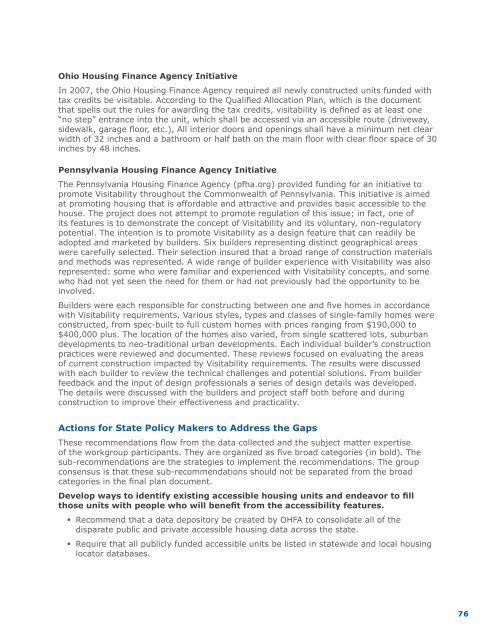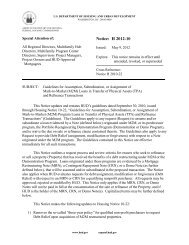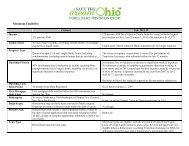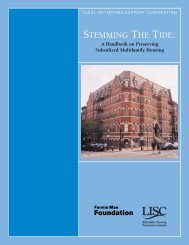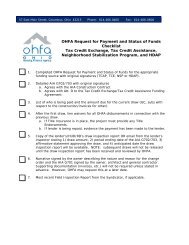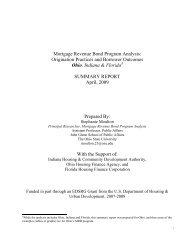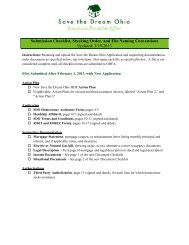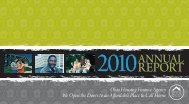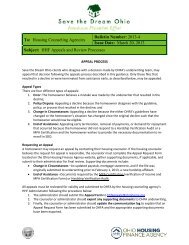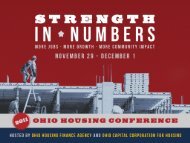OHFA Annual Plan - Ohio Housing Finance Agency
OHFA Annual Plan - Ohio Housing Finance Agency
OHFA Annual Plan - Ohio Housing Finance Agency
Create successful ePaper yourself
Turn your PDF publications into a flip-book with our unique Google optimized e-Paper software.
<strong>Ohio</strong> <strong>Housing</strong> <strong>Finance</strong> <strong>Agency</strong> InitiativeIn 2007, the <strong>Ohio</strong> <strong>Housing</strong> <strong>Finance</strong> <strong>Agency</strong> required all newly constructed units funded withtax credits be visitable. According to the Qualified Allocation <strong>Plan</strong>, which is the documentthat spells out the rules for awarding the tax credits, visitability is defined as at least one“no step” entrance into the unit, which shall be accessed via an accessible route (driveway,sidewalk, garage floor, etc.), All interior doors and openings shall have a minimum net clearwidth of 32 inches and a bathroom or half bath on the main floor with clear floor space of 30inches by 48 inches.Pennsylvania <strong>Housing</strong> <strong>Finance</strong> <strong>Agency</strong> InitiativeThe Pennsylvania <strong>Housing</strong> <strong>Finance</strong> <strong>Agency</strong> (pfha.org) provided funding for an initiative topromote Visitability throughout the Commonwealth of Pennsylvania. This initiative is aimedat promoting housing that is affordable and attractive and provides basic accessible to thehouse. The project does not attempt to promote regulation of this issue; in fact, one ofits features is to demonstrate the concept of Visitability and its voluntary, non-regulatorypotential. The intention is to promote Visitability as a design feature that can readily beadopted and marketed by builders. Six builders representing distinct geographical areaswere carefully selected. Their selection insured that a broad range of construction materialsand methods was represented. A wide range of builder experience with Visitability was alsorepresented: some who were familiar and experienced with Visitability concepts, and somewho had not yet seen the need for them or had not previously had the opportunity to beinvolved.Builders were each responsible for constructing between one and five homes in accordancewith Visitability requirements. Various styles, types and classes of single-family homes wereconstructed, from spec-built to full custom homes with prices ranging from $190,000 to$400,000 plus. The location of the homes also varied, from single scattered lots, suburbandevelopments to neo-traditional urban developments. Each individual builder’s constructionpractices were reviewed and documented. These reviews focused on evaluating the areasof current construction impacted by Visitability requirements. The results were discussedwith each builder to review the technical challenges and potential solutions. From builderfeedback and the input of design professionals a series of design details was developed.The details were discussed with the builders and project staff both before and duringconstruction to improve their effectiveness and practicality.Actions for State Policy Makers to Address the GapsThese recommendations flow from the data collected and the subject matter expertiseof the workgroup participants. They are organized as five broad categories (in bold). Thesub-recommendations are the strategies to implement the recommendations. The groupconsensus is that these sub-recommendations should not be separated from the broadcategories in the final plan document.Develop ways to identify existing accessible housing units and endeavor to fillthose units with people who will benefit from the accessibility features.• Recommend that a data depository be created by <strong>OHFA</strong> to consolidate all of thedisparate public and private accessible housing data across the state.• Require that all publicly funded accessible units be listed in statewide and local housinglocator databases.76


